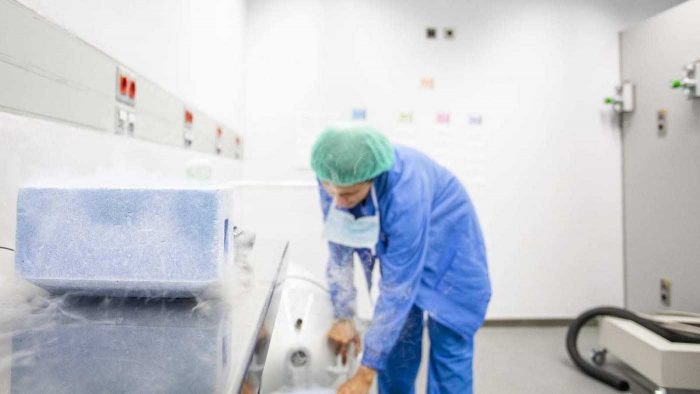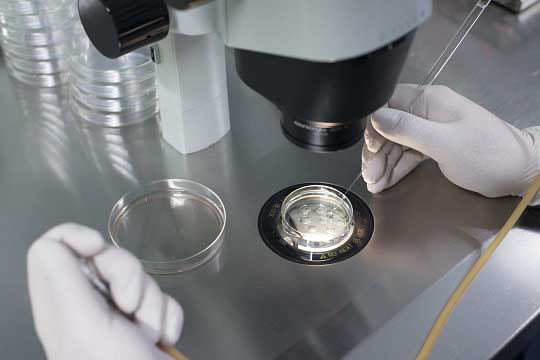

Vitrification of oocytes
The vitrification of oocytes allows women to preserve their fertility and postpone pregnancy to a later date.


The vitrification of oocytes allows women to preserve their fertility and postpone pregnancy to a later date.
As a fertility preservation method, oocyte vitrification is recommended on the same basis as any other fertility preservation treatment:
Vitrification is an advanced cryopreservation method used to freeze oocytes and one of the techniques used in female fertility preservation. By freezing eggs, a woman can have control over her biological clock without experiencing any significant decrease with age in her ability to have a baby. By using vitrification, the eggs retain the same quality upon thawing as they had before being frozen.
RESULTS
Over the last 30 years, IVI has helped more than 250,000 dreams come true.
CARE
97% of our patients recommend IVI. We’re with you at every stage of your treatment, providing support and care.
TECHNOLOGY
IVI has a worldwide reputation for innovative research and has developed and patented pioneering techniques and technologies.
EXPERTISE
IVI is one of the largest fertility treatment providers in the world, with more than 75 clinics in 9 countries.


The main advantage of the vitrification of oocytes in contrast to traditional freezing, also known as slow freezing, is the prevention of ice crystals. Ice crystals, when allowed to form, can damage the oocytes and impact survival rates. By vitrifying oocytes, it removes the risk of ice crystal forming and over 97% survive the process. Furthermore, after thawing, vitrified oocytes achieve the same clinical results in fertility treatments as when fresh oocytes are used.
There are many different vitrification mediums available. However, the Cryotop medium is the most advanced with some of the world’s best results. IVI has pioneered the integration of this medium and is the European leader in its clinical use. With the Cryotop technique, survival figures of up to 97% have been achieved for young patients (<35 years old), with pregnancy rates of 65% and implantation rates of 40%.

The vitrification of oocytes is a solidification process in which the oocytes are treated with cryoprotective substances and submerged in liquid nitrogen at a temperature of -196°C. The steps are the same as in an IVF cycle: stimulation of the ovary with hormones followed by an egg collection procedure. At that point in the process, instead of inseminating and fertilising the eggs, they are vitrified and stored in liquid nitrogen.
This is recommended in numerous and very wide-ranging situations, but the common denominator is when used to postpone fertilisation and/or pregnancy for a later date.
The oocytes can be kept cryopreserved for as long as the patient wants or needs within the legal time limit stipulated by the UK Government.



The vitrification of oocytes is commonly recommended for patients with cancer. This method gives them the option of restoring their fertility after their recovery. In addition, they will retain the same reproductive prognosis that they had when their oocytes were initially vitrified upon diagnosis. Patients who most frequently request treatment at IVI to preserve their fertility are women who have been diagnosed with breast cancer.
If you have been diagnosed with cancer, it is important that you are given all the information and advice you need in terms of your fertility preservation options. This should happen as soon as the diagnosis has been made and treatment with chemotherapy is considered.
Like any patient choosing to preserve their fertility, there are several factors to consider. These include age, ovarian function and follicular reserve. However, for cancer patients, we also need to consider the time available before cancer treatment needs to be started, and whether there is permission from the oncologist. The reproductive prognosis will also depend greatly on the number of oocytes which we succeed in vitrifying. While it is not possible to guarantee pregnancy, there will be the possibility of trying to achieve this through IVF.
Oocyte vitrification is an advanced cryopreservation technique used for freezing oocytes which is widely adopted as a fertility preservation technique for women. By freezing oocytes, a woman can have control over her biological clock without experiencing any significant decline associated with age, as the frozen oocytes retain the quality associated with the woman’s age at the time the vitrification technique is performed.
The main difference between the two methods is the time involved in each; vitrification is a relatively quick process compared to freezing; it also avoids the formation of ice crystals, which are detrimental to subsequent gamete viability
The main advantage of oocyte vitrification compared to traditional freezing is the prevention of ice crystal formation. By vitrifying the oocytes, the risk of ice crystal formation is eliminated and more than 90% of oocytes survive thawing. Furthermore, after devitrification, vitrified oocytes have the same clinical results as fresh oocytes in Assisted Reproduction treatments.
The main advantage of oocyte vitrification compared to traditional freezing is the prevention of ice crystal formation. By vitrifying the oocytes, the risk of ice crystal formation is eliminated and more than 90% of oocytes survive thawing.